
- Cryptocurrency
- October 30, 2025
Table of Contents
Is Your Business Secretly Mining Crypto for Someone Else?
Your systems are slowing down, energy bills are rising, and cloud costs seem off, something doesn’t add up. You could be dealing with cryptojacking, a silent cyberattack where hackers secretly use your devices or servers to mine cryptocurrency.
Unlike typical hacks, nothing appears stolen at first. Instead, your hardware and cloud resources are quietly overworked. Many businesses only notice when productivity drops or unexplained charges start appearing.
Cryptojacking attacks have surged by nearly 400% since 2024, with cloud-based businesses being the main targets. This growing threat drains power, slows performance, and can even damage your systems.
In this guide, you’ll learn how to detect cryptojacking early, stop it fast, and protect your business from further losses, including how to recover affected funds.
What Is Cryptojacking?
Cryptojacking is when attackers use someone else’s computers or cloud servers to mine cryptocurrency without permission. Instead of stealing files, they steal processing power and electricity. That leads to slower systems, higher cloud costs, and damaged hardware, all while the crypto miner runs silently in the background.
Main ways this attack happens:
- Browser-based: A hidden script on a web page runs in visitors’ browsers and mines while the tab is open.
- Malware-based: A fake email, download, or infected USB installs mining software on your device.
- Cloud-based: Poorly configured cloud accounts or exposed APIs allow attackers to initiate mining on your cloud servers.
The cryptojacking software is frequently present in memory or stalls during scans, which means that it could be overlooked by traditional antivirus software. Due to the possibility of renting mining kits and automated tools, cryptojacking has become simpler and more profitable, particularly to companies that are intensive users of cloud computing.
Learn more about what cryptojacking is and how to prevent it in our detailed guide.
What Makes It Harder to Detect?
Most mining tools don’t leave any files on your hard drive. They run directly in your computer’s memory, making it easy for them to slip past antivirus scans. With Cryptojacking-as-a-Service (CaaS), anyone can now rent ready-made mining kits, so even people without technical skills can launch these attacks easily, making detection even more challenging.
Why Cryptojacking Is Rising in 2025: Business Trends Driving the Surge
Cryptojacking has become one of the fastest-growing cyber threats in 2025. It doesn’t crash systems or ask for ransom. It quietly drains resources and creates bigger risks. Here’s why this threat is growing and why your business should take it seriously.
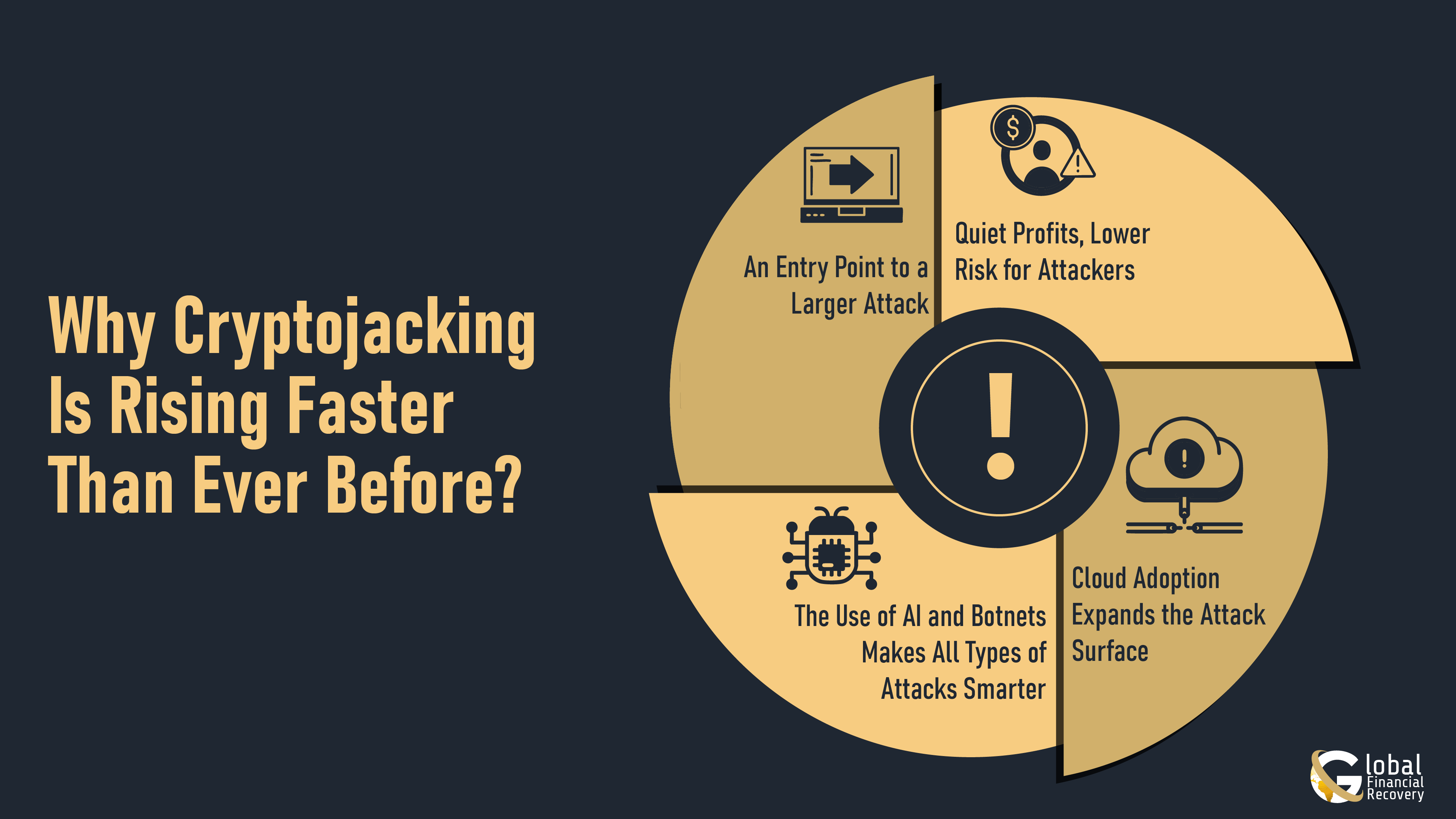
1. Quiet Profits, Lower Risk for Attackers
Cryptojacking works in a way that the victim is not even aware of it, and this is the thing that makes it different from ransomware. The mining software, when it gets into action, operates passively to utilize your company’s systems as an ever-running cryptocurrency mining operation. The low-pressure situation, along with the complex process of tracing, makes it an attractive option for hackers.
2. Cloud Adoption Expands the Attack Surface
As more businesses rely on cloud services like AWS or Azure, attackers find more opportunities for entry. These platforms offer the speed and power hackers need for mining. If access controls or configurations are weak, it’s easy for an attacker to launch hidden mining operations. Most businesses only notice when cloud bills suddenly spike.
3. The Use of AI and Botnets Makes All Types of Attacks Smarter
Hackers are getting smarter. They start automatic software to scan your business network and identify weak points and break-ins, and they do not notice it. After gaining access, they can install mining programs on a large number of devices, including office computers, servers, and even intelligent gadgets, simultaneously.
One point of entry has lost you the control of your devices rapidly and with no feedback on when or how they are being abused.
4. An Entry Point to a Larger Attack
While they may be focused on mining initially, cryptojacking is likely a way to get into your systems, not the end-state attack. Once they get into your system, they might secretly install hidden access points, check your whole network, or prepare to use ransomware or steal data later.
Early detection and action are crucial. It’s not just about stopping mining profits, it’s about stopping the attack itself.
How Cryptojacking Impacts Your Business?
Cryptojacking may stay hidden at first, but the damage builds up fast. It affects your operations, your budget, and your compliance. Here’s what it will really cost businesses in 2025.
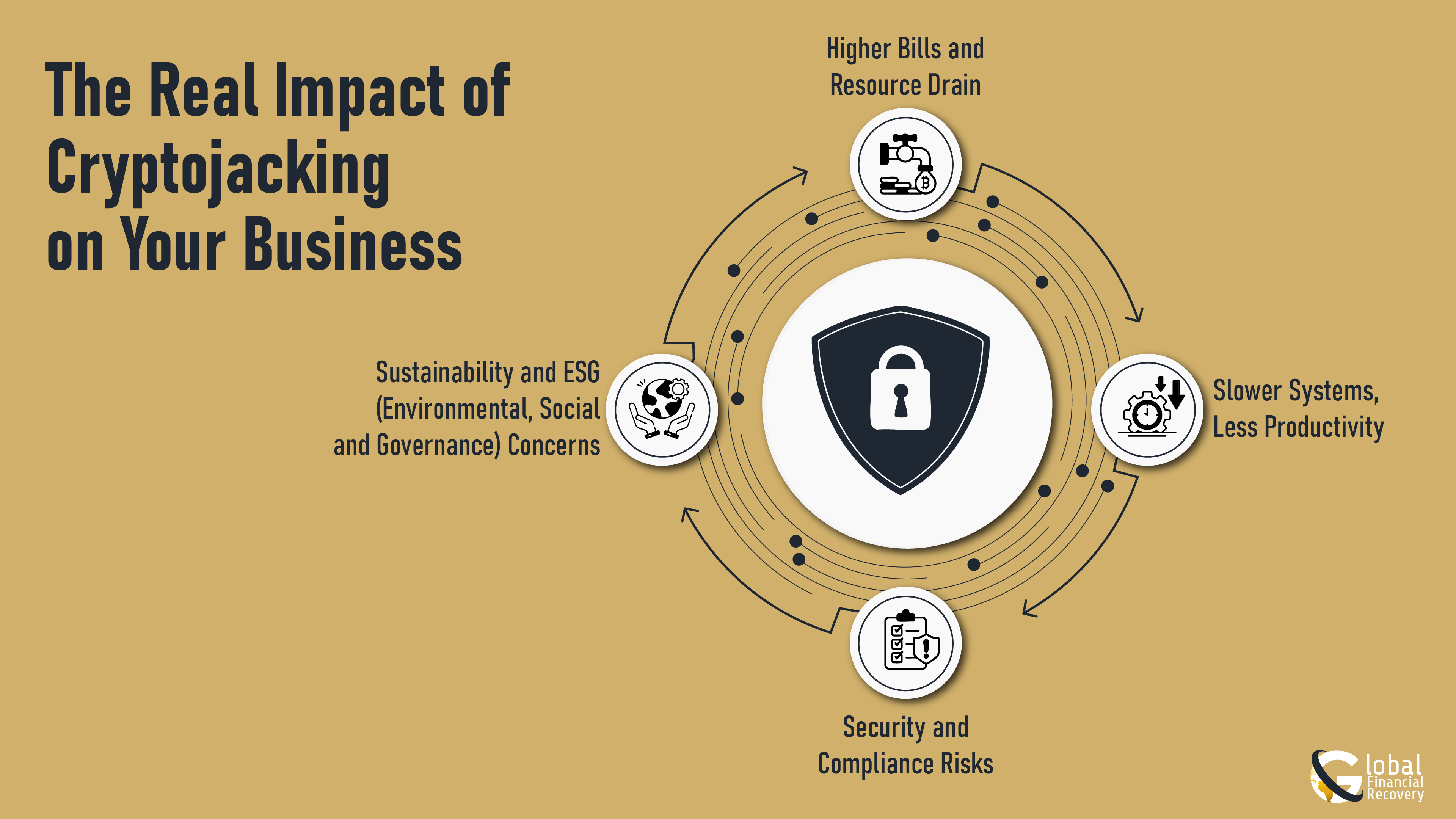
1. Higher Bills and Resource Drain
Mining software uses up your electricity and computing power. This leads to:
- Increased power costs
- Higher charges from cloud providers
- Strain on systems, leading to more frequent repairs or upgrades
Even a small-scale attack running for weeks can cost thousands.
2. Slower Systems, Less Productivity
Cryptojacking pushes devices to their limit. Systems slow down, overheat, or lag, affecting employee workflows and customer service. When your team can’t work efficiently, deadlines slip, and revenue suffers.
3. Security and Compliance Risks
Even if cryptojacking doesn’t steal data, attackers still have access to your systems. This creates the risk, especially if your business handles:
- Customer or employee data
- Payment or health records
- Information covered under laws like GDPR, HIPAA, or PCI-DSS
Failing to report a breach or protect data could lead to penalties or legal trouble.
4. Sustainability and ESG (Environmental, Social and Governance) Concerns
Unauthorized crypto mining increases your carbon footprint and wastes energy. For companies working toward environmental or ESG goals, this hidden activity can:
- Violate internal sustainability policies
- Create problems during audits or public reporting
- Damage your brand if misuse is discovered
Now that we know about how much cryptojacking affects our business, let's look at how cryptojacking works exactly to better understand and prevent such attacks.
How Does Cryptojacking Work?
Cryptojacking steals your computer's processing power to make money for criminals. There are two main ways this happens:
Method 1: Hidden Software Install
a) Getting In
- Fake emails: You get emails that seem authentic (banks, delivery services). The links or attachments will covertly install mining programs. The language of these phishing emails is usually urgent, such as checking your account now.
- Software vulnerabilities: The old software has just made the doors open for attackers to get in without notice. Usually targeted are outdated browsers and operating systems, and outdated or absent security patches in the form of a plug-in.
- Free downloads: Miners install mining code as free programs or applications on suspicious websites. Targets of interest are broken software, free movies, and too good to be true utilities.
- USB devices: Malicious flash disks will automatically introduce Mining software to your computer.
b) Silent Operation
The hidden software runs in the background, staying off your task manager. It wants to remain undetected as long as possible. Advanced versions can:
- Slow down when you're actively using the computer
- Pause during system scans
- Disguise themselves as legitimate processes
c) Mining Process
The program forces your processor and graphics card to solve complex math problems. Your computer essentially works a second job for the criminal.
d) Criminal Profit
Each solved puzzle creates cryptocurrency that goes straight to the attacker's wallet. They earn money using your resources.
e) Staying Power
This software often restarts itself when you boot up, continuing to mine until you find and remove it.
Method 2: Website Trap
a) Hidden Code
Criminals inject small code pieces into legitimate websites or ads. These act like invisible traps. Common targets include:
- Popular news sites
- Social media platforms
- File-sharing websites
- Adult entertainment sites
b) Activation
Simply visiting an infected website triggers the code. You don't need to click anything-just loading the page is enough.
c) Browser Mining
Your web browser immediately starts using significant processing power for cryptocurrency calculations while that tab stays open.
d) Instant Earnings
Criminals earn digital currency as long as you remain on the infected page.
e) Stopping Point
Closing the browser tab usually stops this type of mining, though some scripts try to keep running through hidden windows.
Both methods achieve the same goal: your business computers work harder, consume more electricity, and potentially slow down, all to make criminals money - often without your knowledge for extended periods. The key is recognizing the warning signs early and taking preventive measures.
Now that we’ve seen how these attacks work, let’s look at the doorways they use to get in.
Most Common Entry Points for Cryptojacking
To protect your business from cryptojacking, it’s crucial to understand where these attacks start. Below are the most common entry points attackers exploit in 2025.
|
Entry Point |
Description |
Business Impact |
|
Phishing Emails & Fake Downloads |
Attackers send malicious emails with infected links or attachments. Clicking them installs cryptojacking malware. |
Hidden CPU mining, slow systems, and security breaches |
|
Infected Browser Extensions & Ads |
JavaScript code hidden in browser add-ons or online ads hijacks CPU through browser activity. |
Resource drain while browsing, hard to detect |
|
Software Supply Chain Attacks |
Cryptojacking code is embedded in trusted software updates or tools. |
Mass infection, difficult to trace the source |
|
Misconfigured Cloud Platforms |
Exposed or poorly secured cloud services (e.g., AWS, Azure, GCP) are hijacked for mining. |
Increased cloud costs, performance degradation |
|
Cloud and API Exploitation |
Attackers exploit weakly secured APIs or cloud configurations to inject mining scripts. |
Stealthy mining at scale, risk of lateral attacks |
|
IoT Devices & RDP Vulnerabilities |
Weak IoT firmware or exposed Remote Desktop Protocol ports allow unauthorized access. |
Persistent mining, a potential gateway into networks |
|
Insider Installations (Employees) |
Employees install mining software on company devices knowingly or negligently. |
Internal abuse of resources, policy violations |
Recognizing these access points early can help you implement stronger defenses and avoid silent resource drain and rising operational costs.
How to Detect Cryptojacking in Your Business?
Cryptojacking may stay hidden at first, but the damage builds up fast. It affects your operations, as it is designed to stay hidden. It won’t always trigger alarms, but it quietly drains your systems, slows down the devices, and raises your bills.
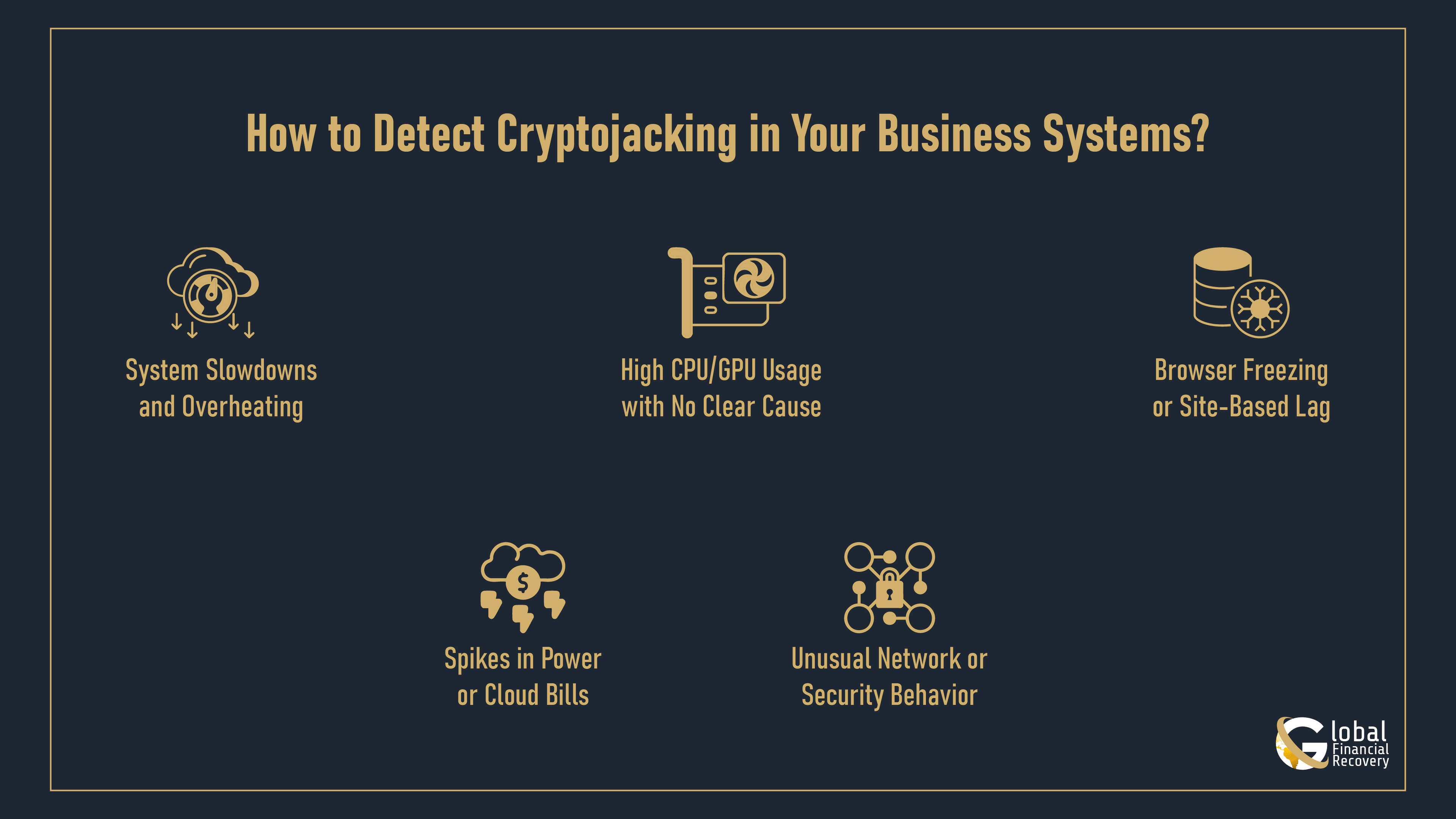
Knowing what signs to look for helps you catch it early, before it turns into costly downtime or hardware damage. Here are the main signs to watch for:
1. System Slowdowns and Overheating
If users are reporting lag in their environments, apps are crashing when nothing heavy is up, or they are having hot machines and nothing heavy is on the machine, it could be more than just using old hardware. Cryptojacking tools hijack the processing power of devices in the background, putting stress on devices while also reducing their longevity.
2. High CPU/GPU Usage with No Clear Cause
If you see unusual spikes in processes, it should raise red flags. Whether it is during browsing or out-of-hours use, if the resources are being used in a way that isn’t clear, it may suggest background mining.
3. Browser Freezing or Site-Based Lag
When systems slow down only during web use, mining scripts might be running in the browser via malicious ads or websites. These are harder to spot because they don’t install files.
4. Spikes in Power or Cloud Bills
Higher-than-normal electricity or cloud infrastructure costs (AWS, Azure) with no business justification may signal unauthorized mining draining your resources.
5. Unusual Network or Security Behavior
If your system connects to unknown sites, shows small antivirus alerts, or has strange log activity, don’t ignore it; these small signs together could mean someone is secretly mining crypto on your network. Some scripts run in memory and vanish on reboot, evading standard scans.
Spotting it early helps, but preventing it entirely is the real goal. Here’s how to shut the door before it even opens.
How to Prevent Cryptojacking Attacks?
Cryptojacking protection isn’t about one tool; it’s about building strong layers of defense across your tech, your team, and your vendors. Here’s how to lock down each layer, in simple terms:
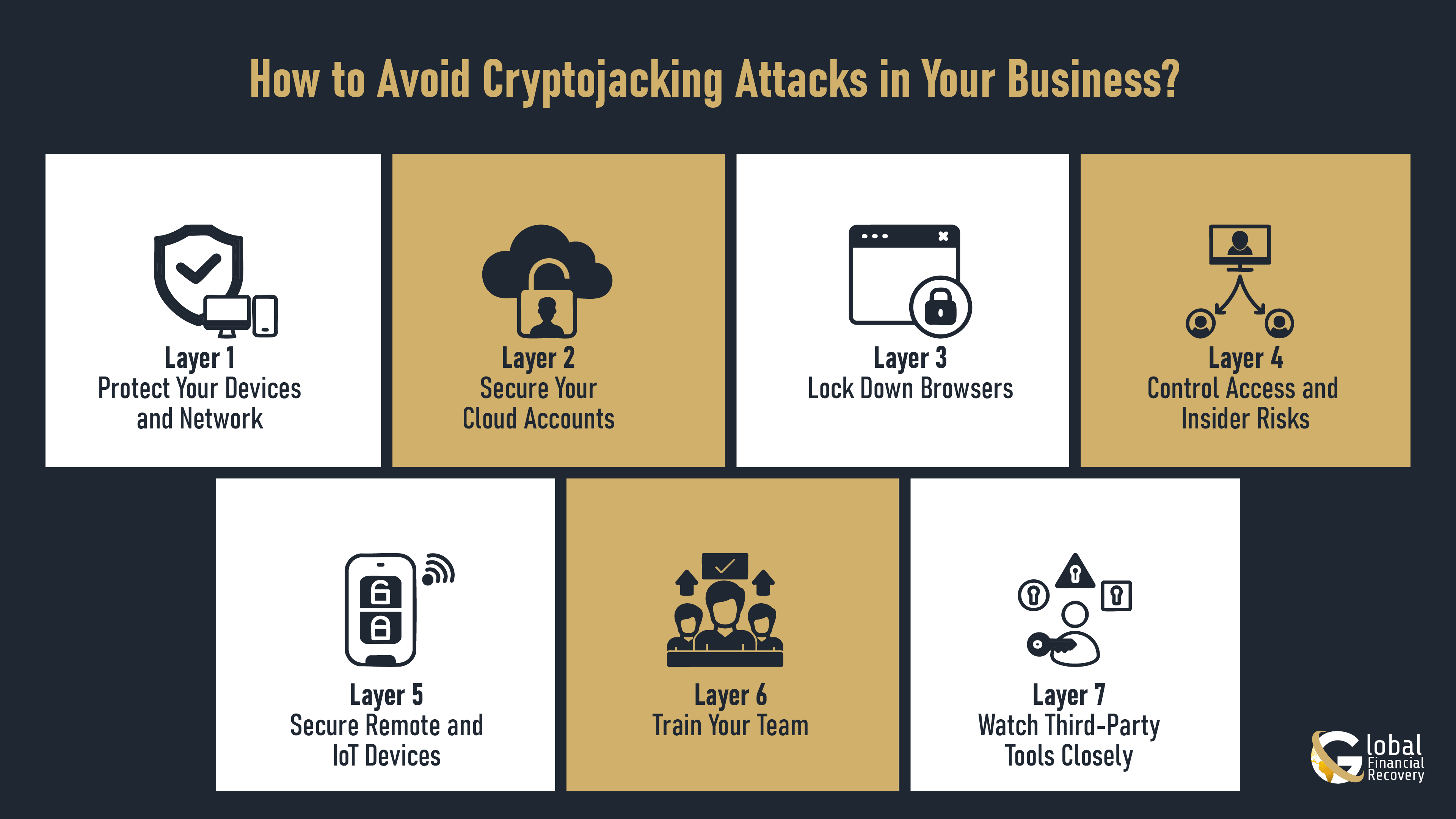
Layer 1: Protect Your Devices and Network
- Install security tools that watch for CPU or GPU misuse.
- Keep systems updated so attackers can’t use old bugs.
- Set alerts for any sudden spike in device performance.
Layer 2: Secure Your Cloud Accounts
- Use strict access controls and detailed activity logs.
- Turn off cloud services or APIs that aren’t being used.
- Watch billing closely; unexpected charges can mean abuse.
Layer 3: Lock Down Browsers
- Use company-wide ad blockers and script filters.
- Only allow approved browser extensions.
- Disable advanced browser features (like WebAssembly) if not needed.
Layer 4: Control Access and Insider Risks
- Limit what employees can access based on their roles.
- Prevent staff from installing unknown software.
- Track late-night logins or device strain after hours.
Layer 5: Secure Remote and IoT Devices
- Change default passwords on all connected devices.
- Close unused ports and require MFA for remote access.
- Regularly scan for unusual device activity or updates.
Layer 6: Train Your Team
- Teach employees how these attacks spread (like through phishing).
- Run practice drills and test response awareness.
- Create an easy way for staff to report anything suspicious.
Layer 7: Watch Third-Party Tools Closely
- Check all vendor tools for security before using them.
- Use tools that scan code libraries for hidden mining scripts.
- Review network logs for strange connections to outside servers.
Cryptojacking creates machine slowdowns while simultaneously draining financial resources and reducing productivity levels, all while indicating fundamental security vulnerabilities. If your business sets up strong layers of defense, you can spot and stop attacks before they start.
What to Do If You Suspect Cryptojacking?
If you see slow systems, higher cloud bills, or hot devices without a reason, it might be cryptojacking. Act fast to limit damage and protect important data for checks.
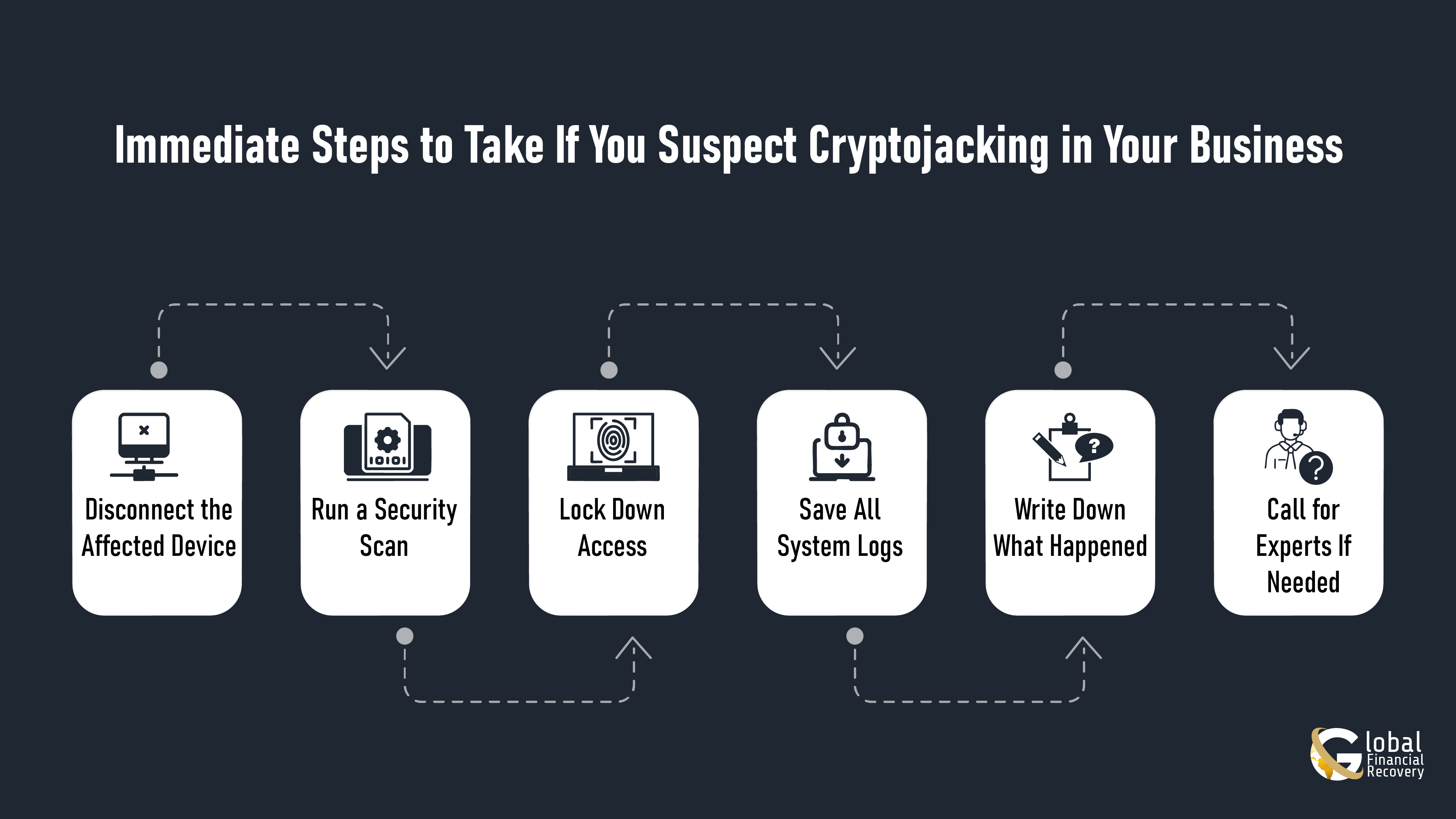
Here’s a quick action plan:
1) Disconnect the Affected Device
Disconnect it from the internet or network right away. This stops the mining process and blocks the attack from spreading.
2) Run a Security Scan
Use a reliable antivirus or anti-malware tool to scan the device and remove any suspicious programs.
3) Lock Down Access
Pause any suspicious user accounts. Change passwords and turn on two-factor authentication for all accounts.
4) Save All System Logs
Don’t delete anything. Logs may show how the attack started and help experts trace it.
5) Write Down What Happened
Keep a simple record: when you noticed the problem, who found it, and what actions you’ve taken so far.
6) Call in Experts If Needed
If it seems involved or if anything has been stolen, reach out to the trusted scam recovery professionals.
Acting promptly provides a greater chance of preventing the attack and developing an understanding of how the situation happened. In some cases of cryptojacking, it may be more than mining and part of a broader breach.
When to Call a Crypto Recovery Firm?
If your computers are running slower than usual, your cloud bills suddenly go up, or devices are getting hot for no reason, cryptojacking might be the cause. Acting fast can reduce the damage and help save important evidence.
Here’s a simple plan to follow:
- Track unusual wallet transactions.
- Investigate how the mining started.
- Secure your systems and protect evidence.
- Help with police reports, legal filings, or insurance claims.
- Review your setup and suggest better protection.
Some attacks are hard to trace or fix alone. If your team can’t find the source or you’re unsure how to respond, reach out to crypto recovery experts for guidance.
Don’t Let Cryptojacking Drain Your Business Behind the Scenes
Hackers use cryptojacking to mine currency without you knowing, causing slow systems and higher bills. Stop it fast if you notice unusual activity. The earlier you respond, the more you can protect, from infrastructure to bottom line.
At Global Financial Recovery, we help businesses trace crypto-mining abuse, gather digital evidence, and recover losses through proper legal channels. Whether it’s cloud-based cryptojacking or compromised corporate networks, our experts are ready to help you act quickly, safely, and confidently.
FAQs (Frequently Asked Questions)
Yes. Poorly secured cloud accounts, exposed APIs, or misconfigured containers let attackers use your cloud CPU/GPU to mine crypto, often causing big unexpected bills. Attackers exploit weak credentials, overly broad IAM roles, unpatched images, or public container registries. Because clouds autoscale, a small compromise can spin up many instances quickly, and the cost shows up as a surprise invoice. Watch for sudden spikes in compute hours, unusual instance types (GPUs you didn’t request), and unexpected outbound traffic. Fixes: tighten IAM permissions, rotate keys, lock down APIs, scan images, and set billing/usage alerts.
Ransomware locks your files and demands payment. Cryptojacking runs quietly in the background to mine crypto for attackers without locking your data.
Not always. Some mining scripts run only in memory or are injected via living-off-the-land tools, so traditional signature-based antivirus can miss them. Add layered defenses: endpoint detection and response (EDR), process-behavior monitoring, network traffic analysis, and cloud-native security tools. Also monitor CPU/GPU usage, set alerts for unusual resource consumption, and keep systems patched.
Yes. Browser-based cryptojacking (drive-by mining) can run as soon as you visit an infected page or see a malicious ad; no click or download is needed.
Monero is privacy-focused and designed to be hard to trace, so attackers prefer it. Its privacy features (like obfuscated transaction data and strong anonymity protections) make it difficult to link mined coins back to the miner. Monero is also relatively CPU-friendly compared with some coins, so it can be mined effectively on compromised servers and desktops without specialized hardware.
